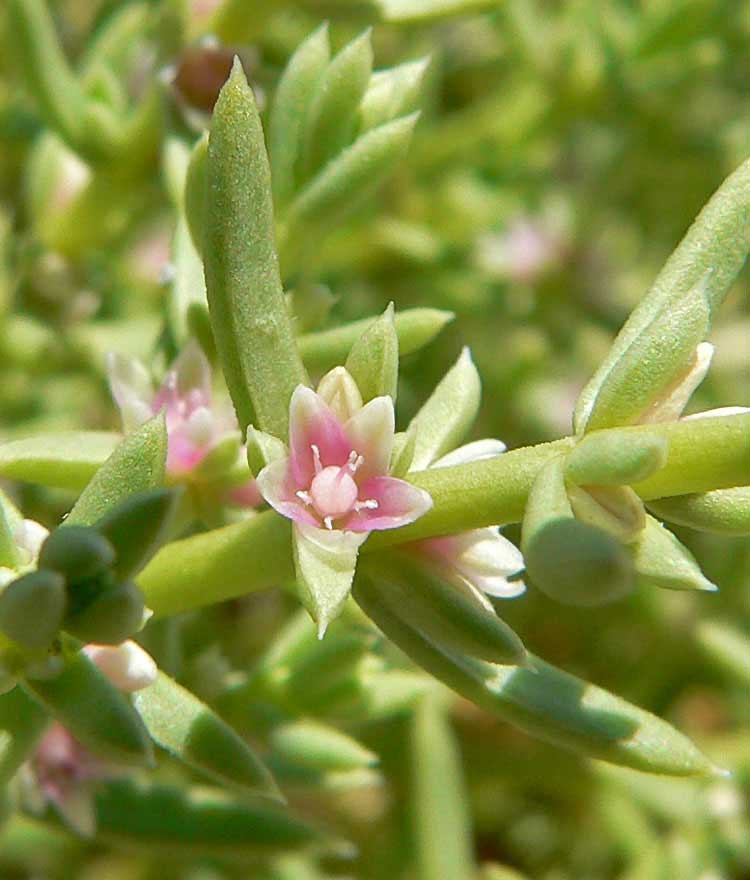
Nitrophila occidentalis (*)
Classification System: APG IV
Superregnum: Eukaryota
Regnum: Plantae
Cladus: Angiosperms
Cladus: Eudicots
Cladus: Core eudicots
Ordo: Caryophyllales
Familia: Amaranthaceae s.l.
Cladus: Amaranthaceae s.str.
Subfamilia: Polycnemoideae
Tribus: Polycnemeae
Genus: Nitrophila
Species: N. occidentalis
Name
Nitrophila occidentalis (Moq.) S.Watson, Botany [Fortieth Parallel] 297. (1871)
Synonyms
Basionym
Banalia occidentalis Moq., Prodr. [A. P. de Candolle] 13(2): 279. (1849)
Type locality: U.S.A.: Oregon.
Holotype: Nuttall. Herb. Hook.
Homotypic
Halimocnemis occidentalis Nutt. ex Moq., Prodr. [A. P. de Candolle] 13(2): 279. (1849), nom. inval. in syn.
Heterotypic (ref. Masson & Kadereit, 2013, Govaerts 2019)
Glaux acutifolia A. Heller, Muhlenbergia 2: 109. (1906)
Type locality: U.S.A.: California. Siskiyou County, Gazelle, Shasta Valley.
Holotype: 1905-06-20, Heller, A.A. #8073. CAS CAS00123920; Isotypes: AC AC00320298, CAS00123919, E E00062034, F F0067869F, G G00440603, GH GH00037209, MO MO-954649, NY NY00214735, NY00329474, PH PH00012246, US US00116554.
(ref. Hassler 2019)
Nitrophila mexicana Ulbr., Nat. Pflanzenfam., ed. 2 [Engler & Prantl] 16c: 455. (1934)
Distribution
Native distribution areas:
Northern America
Northwestern U.S.A.
Oregon
Southwestern U.S.A.
California, Nevada, Utah
Mexico
Mexico Northwest
References: Brummitt, R.K. 2001. TDWG – World Geographical Scheme for Recording Plant Distributions, 2nd Edition
References
Primary references
Watson, S. 1871. Botany. In: United States Geological Expolration of the Fortieth Parallel [sic!]. Vol. 5. BHL Reference page. : 297
Moquin-Tandon, A. 1849. Salsolaceae. In: De Candolle, A.P. (ed.): Prodromus systematis naturalis regni vegetabilis 13(2): 41–219. Masson, Paris. BHL Reference page. : 279
Heller, A.A. 1905–1906. Botanical exploration in California. Season of 1905. Muhlenbergia 2(1C): 1–176. BHL Reference page. : 109
Additional references
Masson, R. & Kadereit, G. 2013. Phylogeny of Polycnemoideae (Amaranthaceae): Implications for biogeography, character evolution and taxonomy. Taxon 62 (1): 100–111. DOI: 10.1002/tax.621009 JSTORReference page.
eFloras 2008. Nitrophila occidentalis in Flora of North America . Missouri Botanical Garden, St. Louis, MO & Harvard University Herbaria, Cambridge, MA.
Links
Hassler, M. 2019. Nitrophila occidentalis. World Plants: Synonymic Checklists of the Vascular Plants of the World In: Roskovh, Y., Abucay, L., Orrell, T., Nicolson, D., Bailly, N., Kirk, P., Bourgoin, T., DeWalt, R.E., Decock, W., De Wever, A., Nieukerken, E. van, Zarucchi, J. & Penev, L., eds. 2019. Species 2000 & ITIS Catalogue of Life. Published online. Accessed: 2019 Nov. 19. Reference page.
International Plant Names Index. 2019. Nitrophila occidentalis. Published online. Accessed: Nov. 19 2019.
Govaerts, R. et al. 2019. Nitrophila occidentalis in Kew Science Plants of the World online. The Board of Trustees of the Royal Botanic Gardens, Kew. Published online. Accessed: 2019 Nov. 19. Reference page.
Tropicos.org 2019. Nitrophila occidentalis. Missouri Botanical Garden. Published online. Accessed: 19 Nov. 2019.
Vernacular names
English: Western niterwort, Boraxweed
Nitrophila occidentalis is a species of flowering plant in the family Amaranthaceae known by the common name boraxweed and sometimes western niterwort. It is native to the western United States and northern Mexico, where it can be found in habitat with moist alkaline soils, such as salt pans. It is a rhizomatous perennial herb producing decumbent or erect stems up to about 30 centimeters tall. The stems have paired branches lined with oppositely arranged, fleshy, linear or oblong green leaves up to 1.6 centimeters in length. Flowers occur in the leaf axils, alone or in clusters of up to 3, accompanied by small bracts. The flower lacks petals but has five pointed sepals 1 or 2 millimeters long which are white or pink in color, fading white with age.
Retrieved from "http://en.wikipedia.org/"
All text is available under the terms of the GNU Free Documentation License

